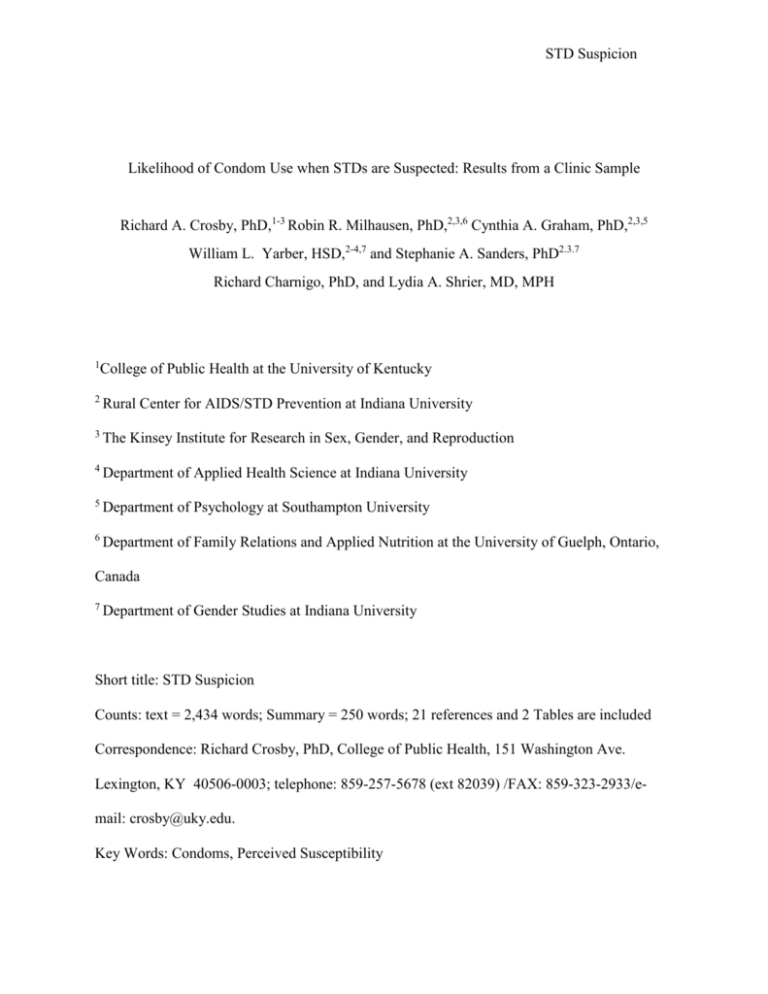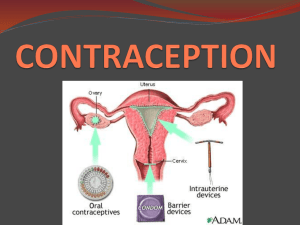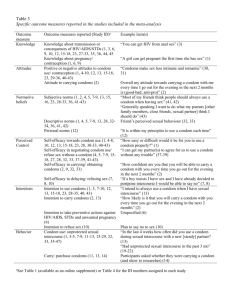
STD Suspicion
Likelihood of Condom Use when STDs are Suspected: Results from a Clinic Sample
Richard A. Crosby, PhD,1-3 Robin R. Milhausen, PhD,2,3,6 Cynthia A. Graham, PhD,2,3,5
William L. Yarber, HSD,2-4,7 and Stephanie A. Sanders, PhD2.3.7
Richard Charnigo, PhD, and Lydia A. Shrier, MD, MPH
1
College of Public Health at the University of Kentucky
2
Rural Center for AIDS/STD Prevention at Indiana University
3
The Kinsey Institute for Research in Sex, Gender, and Reproduction
4
Department of Applied Health Science at Indiana University
5
Department of Psychology at Southampton University
6
Department of Family Relations and Applied Nutrition at the University of Guelph, Ontario,
Canada
7
Department of Gender Studies at Indiana University
Short title: STD Suspicion
Counts: text = 2,434 words; Summary = 250 words; 21 references and 2 Tables are included
Correspondence: Richard Crosby, PhD, College of Public Health, 151 Washington Ave.
Lexington, KY 40506-0003; telephone: 859-257-5678 (ext 82039) /FAX: 859-323-2933/email: crosby@uky.edu.
Key Words: Condoms, Perceived Susceptibility
STD Suspicion
2
Abstract
Objective: To determine the event-level associations between perceived risk of STD
acquisition/transmission and condom use during penile-vaginal intercourse (PVI) among STD
clinic attendees.
Methods: A convenience sample (N=622) completed daily electronic assessments. Two
questions were proxies of perceived risk: suspicion that the partner might currently have an
STD and that “you” might currently have an STD. Participants reported whether condoms were
used with PVI events in the past 24 hours. Generalized estimating equations determined the
association between each of the perceived risk variables and event-level condom use.
Results: For the model pertaining to suspicion of sex partner infection, there were 16,674
events of PVI, with condom use during 10,552 of these events. The effect of current suspicion
was significant after adjusting for gender and whether participants identified as African
American/Black (Estimated Odds Ratio=2.17, 95% CI=1.57-3.00, P=.0001). The model
pertaining to suspicion of self-infection included 16,679 events of penile-vaginal sex, with
condom use during 10,557 of these events. Again, the effect of current suspicion was
significant after adjusting for gender and African American/Black race (Estimated Odds
Ratio=2.05, 95% CI=1.43-2.40, P=.0001). Tests for interactions with gender and with race
were non-significant (all > .25 p-values).
Conclusion: Using an event-level, research design, strong associations were found between
perceptions of STD risk and condom use in a clinical population. Health care providers and
other professionals may indirectly promote condom use by helping clinic patients realistically
evaluate their risk of having sex with infected partners or of being a source of STDtransmission to others.
STD Suspicion
3
Introduction
Evidence strongly supports that condoms have protective value against sexually
transmitted diseases (STDs) (Crosby & Bounse, 2011; Koss, Dunne, & Warner, 2009; Warner
et al., 2005). Researchers have demonstrated that a complex web of factors at the individual,
relational and broader social level impact condom use behavior (DiClemente, Salazar, &
Crosby, 2007). Among these, individual-level factors have been the focus of many
interventions directed at achieving behavioral change (DiClemente et al., 2007). First brought
to the forefront by the Health Belief Model (Janz & Becker, 1984), the construct of perceived
susceptibility has been a central construct in many of these interventions. Perceived
susceptibility refers to one’s subjective perception of the risk of contracting a disease or illness
(Janz & Becker, 1984).
Despite strong research demonstrating the utility of the concept of perceived
susceptibility prior to the mid-1970s, recent research has yielded inconclusive findings (Baume,
2000). With respect to perceptions of STI acquisition and transmission, published findings
suggest limited utility of this predictor variable for models of condom use behavior (Eng &
Butler, 1997; Sheeran, Abraham, & Orbell, 1999). This may be attributable to inadequate
research methodology (Eng & Butler, 1997) rather than an inherent lack of association between
perceived risk of STIs and condom use behavior (Kowalewski, Henson, & Longshore, 1997).
For example, most studies of HIV risk perception are based on cross-sectional survey data, in
which perceived susceptibility is measured using retrospective recall periods that are vulnerable
to memory bias (Kowalewski et al., 1997). In contrast, event-level data transcends cause-andeffect limitations by using each specific sexual event as the unit of analysis, i.e., behaviors are
measured in real time, linking the predictor variable with the outcome variable in temporal
sequence (Crosby, DiClemente, Yarber, Snow, & Troutman, 2008; Hensel, Stupiansky,
STD Suspicion
4
Herbenick, & Dodge, & Reece, 2011; Shrier, Walls, Lops, & Feldman, 2011; Warner et al.,
2005).
Further, STD risk perception can be conceptualized at two levels. In the parlance of the
Health Belief Model, only an individual’s risk of acquisition of infection is included
(Rosenstock, Strecher, & Becker, 1994). Because of the dyadic nature of sexual encounters, a
second level of risk is critical: transmission of disease to a partner. When risk of transmission is
considered only as a unidirectional process, only one half of the disease prevention equation is
addressed. Nonetheless, perceived risk of STD transmission from self to partner has not been
studied empirically. Finally, much of the research on perceived susceptibility has relied on
predominantly white (Winfield & Waley, 2002) and/or college student samples (Noar &
Zimmerman, 2005; Sheeran et al., 1999). Few investigations have examined the utility of the
construct among ethnically diverse or among higher-risk clinic-based samples in which
individuals are more likely to report a history of STD infection (Manhart et al., 2004).
Accordingly, the purpose of this study was to determine the event-level association
between perceived risk of both STI acquisition and transmission and actual condom use during
penile-vaginal intercourse (PVI) among female and male STD clinic attendees. As gender has
been documented to influence perceived risk (e.g., Robertson, Stein, & Baird-Thomas, 2006),
this study also examined the moderating effect of gender in the association between perceived
risk of STDs and condom use. Because the STD disease epidemic has heavily impacted the
Black African-American population (CDC, 2012), we also examined the possible moderating
role of Black versus non-Black race.
STD Suspicion
5
Methods
Study Sample
Data were collected from December 2007 through April 2011 as part of an NIH-funded
study of condom effectiveness. A convenience sample was enrolled. All participants were
tested for Chlamydia, gonorrhea, and trichomoniasis by urine-based nucleic acid amplification
tests; those testing positive were treated with single-dose therapy. Patients were recruited from
five clinics caring for individuals at high-risk for STI in three U.S. cities: a publicly-funded STI
clinic in the Southern US; a publicly-funded STI clinic in the Midwestern US; and an STI clinic
of a large teaching hospital and two adolescent medicine clinics affiliated with a children’s
hospital, all in the Northeastern US. The STI clinics enrolled individuals aged 18 years and
older; the adolescent clinics enrolled individuals as young as 15. Eligibility criteria included
reporting penile-vaginal intercourse in the preceding 3 months; speaking English; willing to
provide contact information; and providing written informed consent. Institutional review
boards at the participating universities approved the study protocol with a waiver of parental
consent for adolescents less than 18 years of age.
Recruitment procedures varied slightly across the five clinics. At the adolescent clinics,
the study was listed on a research recruitment flag attached to the appointment paperwork of
age-eligible patients. The research assistant used the flag to identify eligible patients. This
chart-flagging system at adolescent clinics precluded us from calculating a participation rate for
those sites. Across the three remaining clinics, 1,424 patients agreed to be screened for
eligibility. Of these, 1,297 were eligible and invited to participate; 794 enrolled, yielding a
participation rate of 61.2%. With the remaining patients recruited from the Boston clinics
(n=135), the participant sample size of the larger study on condom effectiveness was 929.
STD Suspicion
6
Participants were trained in the use of an electronic diary report using a passwordprotected personal digital assistant (PDA) programmed with the Configurable Electronic RealTime Assessment System (CERTAS; Personal Improvement Computer Systems, Inc. Reston,
VA, USA). Each day, participants were prompted to answer the question of whether they had
sex in the past 24 hours. Because the research question pertained to urethral/vaginal acquisition
of STIs, our assessments concerned penile-vaginal sex. Based on formative research,16 we
defined sex as “putting the penis in the vagina” and the end of sex as the male orgasm. If
participants responded affirmatively, they were asked questions about each instance of sexual
intercourse. They were also asked to enter a report about their sexual behavior directly into the
PDA after each time that they had sex to maximize capture of data on every sex event. These
PDA diaries were kept by participants for up to 180 days post-enrollment; however, due to
attrition completed diaries for the current study were only available for 622 participants.
Measures
Two key questions from the daily diary assessments were used as a proxy for perceived
risk: 1) “Before you had sex did you have any reason at all to suspect that you might currently
have an STD that might be transmitted to your partner during sex?” (suspicion-self) and 2)
“Before you had sex did you have any reason at all to suspect that your partner might currently
have an STD that might be transmitted to you during sex?” (suspicion-partner). Daily
assessments also captured condom use at last sex: “Did you or your partner use a condom for
the penis-in-vagina part of the sex event?”
Data Analysis
After conducting basic cross-tabulations, multivariate logistic regression models were
used to test associations between suspicions of current infections and condom use for PVI. The
models included gender and race (black versus non-black) as well as interaction terms (entered
STD Suspicion
7
concurrently) between these covariates and the perceived risk variables. Because of the
correlations inherent to multiple observations on the same participant (i.e., the use of sex events
as the observation units), generalized estimating equations (GEE) models, utilizing an
exchangeable correlation matrix, were employed for all analyses. Analyses were performed
with SPSS (version 19.0).
Results
Descriptive Findings
The mean age of the sample was 29.9 years (SD = 10.45). Of the 622 participants
59.3% identified as African American/Black and 63.1% were female. About one of every four
(25.7%) participants was 20 years of age or younger at enrollment. Just over one-half (54.9%)
of the participants reported being unemployed. About four of every ten (43.8%) had a high
school education or less.
Table 1 provides the descriptive bivariate information pertaining to frequency of
condom use stratified by suspicion of partner being infected and by suspicion of self-infection.
For convenience, rows are provided for the total sample, males only, and females only. As
shown, condoms were used for at least 80% of the 1,202 events when the sex partner was
suspected of infection whereas this value was far lower (58.9% – 66.7%) during the 15,478
events when partner infection was not suspected. Also, condoms were used for at least 80% of
the 1,177 events occurring when participants suspected self-infection whereas this value was,
again, far lower (59.0% – 66.5%) during the 15,508 events occurring when self-infection was
not suspected.
Multivariate Findings
STD Suspicion
8
Table 2 presents the results of the two GEE models used to estimate the adjusted odds
ratios for the effect of suspicion-self and suspicion-partner on condom use. Suspicion-self and
suspicion-partner were significantly associated with event-level condom use in the two models.
The model pertaining to suspicion-partner is shown in the top half of Table 2. This
model included 16,674 events of PVI, with condoms being used during 10,552 (63.3%) of these
events. During 1,202 of the events (7.2%), participants suspected his/her sex partner had an
STD. As shown, suspicion-partner was significantly associated with condom use, with condom
use being more than twice as likely during penile-vaginal sex events when this suspicion was
present. Gender was not significantly related to condom use; however, race did achieve
significance in this model. The model suggests that African American/black men and women
were about 80% more likely to use condoms. Tests for interactions between suspicion-partner
and gender (P = .68) and suspicion-partner and race (P = .46) were not significant.
The model pertaining to suspicion-self is shown in the bottom half of Table 2. This
model included 16,679 events of PVI, with condoms being used during 10,557 (63.3%) of these
events. During 1,177 of the events (7.0%), participants suspected their sex partner had an STD.
As shown, suspicion-self and race was associated with condom use. The model suggested that
when participants suspected self-infection they were more than twice as likely to use condoms.
The model also suggests that, beyond the effect of suspicion-self, condom use was about 80%
more likely for participants identifying as African American/Black. Tests for interactions
between suspicion-self and gender (P = .28) and suspicion-self and race (P = .83) were not
significant.
Discussion
STD Suspicion
9
The findings from novel investigation of women and men attending STD clinics suggest
that perceptions of STD infection that individuals held just prior to having sex were associated
with condom use for that specific sexual encounter. Specifically, the event-level analysis of
clinic attendees demonstrated that condom use was nearly twice as likely to occur when the
event of PVI involved suspicion that either the individual or his/her partner might currently
have an STD that could be transmitted during sex. This association was evident for men and
women, meaning that both genders should be the focus of intervention efforts regarding
perceived risk of STD acquisition and transmission. Further, this relationship was present
regardless of whether participants identified as African American/Black. Also, African
American/Black men and women were more likely than non-African American/Black men and
women to use condoms irrespective of their perception of STD risks.
Though published findings suggest limited value of the construct of perceived risk
relative to condom use behaviors, this study showed robust utility. Event-level assessments
represent a methodological improvement over retrospective, more global assessments. This
study used ecological momentary assessments of both predictor and outcome variables and
assessed perceived risk at two-levels (self-to-partner and partner-to-self). This measurement
approach may account for inconsistencies between some of the previous research that failed to
find an association (Baume & Middlestadt, 1996 as cited in Baume, 2000) between perceived
risk of infection and condom use and the current investigation.
Though it is reassuring that participants who perceived there was a risk for transmission
of STD were more likely to use condoms, it is concerning that approximately 93% of the events
involved no suspicion of risk for self-to-partner or partner-to-self transmission. This is
particularly troubling given the sample was comprised of newly tested clinic patients. An
abundance of research supports the idea that individuals are notoriously poor at accurately
STD Suspicion
10
assessing their risk for STD infection (East, Jackson, O’Brien & Peters, 2007; Kershaw, Ethier,
Niccolai, Lewis, & Ickovics, 2003; Kowalewski et al., 1997). Moreover, individuals may be
unlikely to suspect that they might acquire an STD from a partner with whom they choose to
have sex. Perceptions of a relationship as characterized by trust, intimacy and connection may
invoke a false sense of security against infection (Bolton, McKay, & Schneider, 2010). Further,
despite higher rates of STD infection among blacks (CDC, 2012), the rate of suspicion of was
not elevated among this subgroup of participants. Nonetheless, they were more likely to use
condoms.
Study findings have implications for clinicians and other clinical staff working with
STD clinic attendees. STD clinical staff should seek to educate all attendees about the
behaviors that put them at risk for STD acquisition or transmission. Further, clinical staff
should also help individuals to raise their perceptions of personal susceptibility to STD
infection to levels commensurate with their actual risk practices (Elifson, Klein, & Sterk,
2010). The clinical encounter provides an important teachable moment to educate about risk
and promote condom use, regardless of diagnosis. For those testing positive, further counseling
regarding heightened risk of STD transmission during the posttreatment is vital.
For clinicians and clinical staff should note that although perceived risk is not a
sufficient basis for behavior change, it is nonetheless a necessary precondition of behavior
change (Napper, Fisher, & Reynolds, 2011). Therefore clinicians should engage in the
provision of behavioral skills related to condom negotiation, correct use of condoms, and the
consistent use of condoms as well as the provision of condoms that are preferred by their
clients.
Limitations and Future Research
STD Suspicion
11
This study of STD clinic attendees from five clinics across three cities is constrained by
the validity of self-report, as is true for most sexuality research, and its generalizability to other
populations may be limited. The event-level analysis, while valuable, may not equally represent
all study participants in that individuals vary in the number of events they have contributed to
the dataset; however, the GEE models accommodate this by using estimated odds ratios. We
did not collect any information about why individuals suspected that they or their partner might
currently have any STD; future qualitative studies should be carried out to elucidate the
possible origins of suspicion. Also, future research might also investigate whether recent
treatment of an STD affects subsequent perceptions of STD acquisition/transmission risk.
Conclusions
Using an event-level research design, this study found that condom use was associated
with participants’ suspicion that they or their partner might currently have an STD that could be
transmitted during the sexual event. This association occurred regardless of gender and race.
Health care providers, as a part of teaching information, motivation and behavioral skills,
should help individuals develop more realistic assessments of risk for transmission of STD.
STD Suspicion
12
Acknowledgements
Support for this project was provided by a grant to the first author from the National Institutes
of Allergies and Infectious Diseases, grant # 5 R01 AI068119.
STD Suspicion
13
References
Baume, C. A. (2000). The relationship of perceived risk to condom use: why results are
inconsistent. Social Marketing Quarterly, 6, 33-42.
Bolton, M., McKay, A., & Schneider, M. (2010). Relational influences on condom use
discontinuation : A qualitative study of young adult women in dating relationships.
Canadian Journal of Human Sexuality, 19, 91-104.
Centers for Disease Control and Prevention. HIV Among African Americans. Fact Sheet.
November 2011. Available at: http://www.cdc.gov/hiv/topics/aa/PDF/aa.pdf. Accessed
June 18, 2012.
Crosby, R. A., DiClemente, R. J., Yarber, W. L., Snow, G., & Troutman, A. (2008). An eventspecific analysis of condom breakage among African American men at risk of HIV
acquisition. Sexually Transmitted Diseases, 35, 174-178.
Crosby, R. A., & Bounse, S. (2012). Condom effectiveness: Where are we now? Sexual Health,
9, 10-17.
DiClemente, R. J., Salazar, L. F., & Crosby, R. A. (2007). A review of STD/HIV preventive
interventions for adolescents: sustaining effects using an ecological approach. Journal of
Pediatric Psychology, 32, 888-906.
Elifson, K. W., Klein, H., & Sterk, C. E. (2010). Factors associated with condom use among
young adult ecstasy users. International Journal of Public Health, 55, 571-9.
Eng, T. R., & Butler, W. T. (1997). The hidden epidemic: Confronting sexually transmitted
diseases. Washington, DC: National Academy Press.
Hensel, D. J., Nathan, W., Stupiansky, N. W., Herbenick, D., Dodge, B., Reece, M. (2011).
When condom use is not condom use: An event-level analysis of condom use behaviors
during vaginal intercourse. Journal of Sexual Medicine, 8, 28-34.
Janz, N. K. & Becker, M. H. (1984). The health belief model: a decade later. Health Education
Quarterly, 11, 1–47.
Koss, C. A., Dunne, E. F., & Warner L. (2009). A systematic review of epidemiologic studies
assessing condom use and risk of syphilis. Sexually Transmitted Diseases, 7, 401-405.
Kowalewski, M. R., Henson, K. D., & Longshore, D. (1997). Rethinking perceived risk and
health behavior: A critical review of HIV prevention research. Health Education and
Behavior, 24, 313-325.
Manhart, L. E., Aral, S. O., Holmes, K. K., Critchlow, C. W., Hughes, J. P., Whittington, W. L.
H., & Foxman, B. (2004). Influence of study population on the identification of risk
factors for sexually transmitted diseases using a case-control design: the example of
gonnorrhea. American Journal of Epidemiology, 160, 393-402.
STD Suspicion
14
Napper, L. E., Fisher, D. G., & Reynolds, G. L. (2011). Development of the Perceived Risk of
HIV Scale. AIDS and Behavior, 1075-1083.
Noar, S. M. & Zimmerman, R. A. (2005). Health Behavior Theory and cumulative knowledge
regarding health behaviors: Are we moving in the right direction? Health Education
Research, 20, 275-290.
Robertson, A. A, Stein, J. A., & Baird-Thomas, C. (2006). Gender differences in the prediction
of condom use among incarcerated juvenile offenders: Testing the InformationMotivation-Behavior Skills (IMB) model. The Journal of Adolescent Health, 38, 18-25.
Rosenstock, I. M., Strecher, V. J., & Becker, M. H. (1994). The Health Belief Model and HIV
risk behavior change. In R. J. DiClemente & J. L. Peterson (Eds.), Preventing AIDS:
Theories and methods of behavioral interventions (pp. 5-24). New York: Plenum.
Sheeran, P., Abraham, C., & Orbell, S. (1999). Psychosocial correlates of heterosexual condom
use: A meta-analysis. Psychological Bulletin, 125, 90-132.
Shrier, L. A., Walls, C., Lops, C., Feldman, H. A. (2011). Correlates of incorrect condom use
among depressed young women: An event-level analysis. Journal of Pediatric and
Adolescent Gynecology, 24, 10-14.
United States Department of Health and Human Services. Workshop Summary: Scientific
evidence on condom effectiveness for sexually transmitted disease (STI) prevention.
Available on-line at http://www.niaid.nih.gov/dmid/STIs/condomreport.pdf. Accessed
July 5, 2011.
Warner, L., Macaluso, M., Austin, H. D., Kleinbaum, D. K., Artz, L., Fleeno, M. E., Brill, I.,
Newman, D. R., Hook, E. W. (2005). Application of the case-crossover design to reduce
unmeasured confounding in studies of condom effectiveness. American Journal of
Epidemiology, 161, 765-773.
Winfield, E. B., & Whaley, A. L. (2002). A comprehensive test of the Health Belief Model in
the prediction of condom use among African American college students. Journal of Black
Psychology, 28, 330-346.
STD Suspicion
15
Table 1. Descriptive Statistics for Event-Level Condom Use according to Suspicion of STD in Partner and in Self,
Total and by Gender
N (%) using condoms
N (%) using condoms
when suspicion of STD
when no suspicion of STD
Suspect sex partner is infected
994/1,202 (82.7)
9,558/15,478 (61.8)
Suspect sex partner is infected (males only)
397/493 (80.5)
3,776/5,664 (66.7)
Suspect sex partner is infected (females only)
597/709 (84.2)
5,782/9,814 (58.9)
Suspect “I am” infected
977/1,177 (83.0)
9,580/15,508 (61.8)
Suspect “I am” infected (males only)
394/472 (83.5)
3,781/5,687 (66.5)
Suspect “I am” infected (females only)
583/705 (82.7)
5,799/9,821 (59.0)
___________________________________________________________________
STD Suspicion
Table 2. Adjusted Event-Level Associations Between Suspicions of STDs and Condom Use
Model 1: 621 participants (16,674 events)
Suspect sex partner is infected
Gender
Race
EOR1
95% CI2
P
2.17
1.57-3.00
.0001
.83
.65-1.08
.16
1.84
1.43-2.40
.0001
Model 2: 622 participants (16,679 events)
Suspect “I am” infected
Gender
Race
2.05
1.43-2.92
.83
.64-1.07
1.80
1.40-2.30
.0001
.15
.0001
___________________________________________________________________
16
STD Suspicion
17





